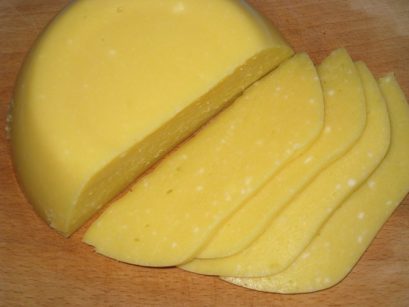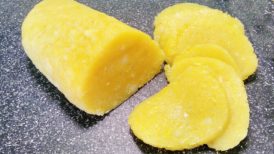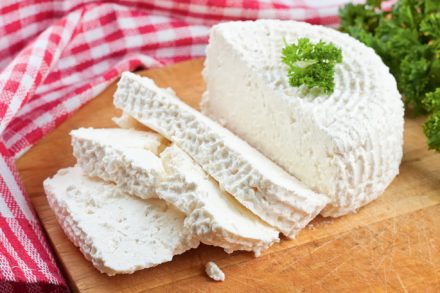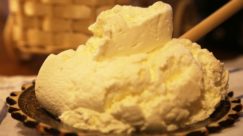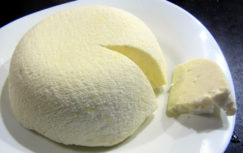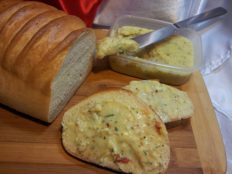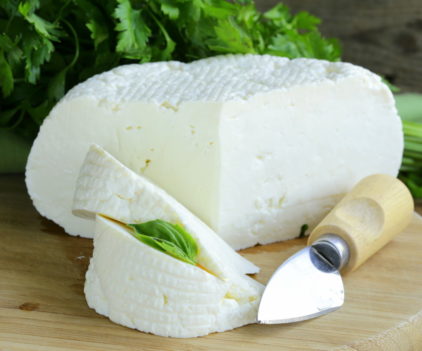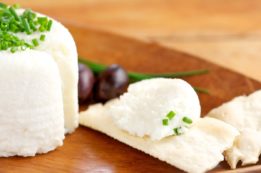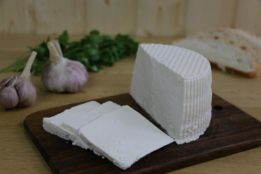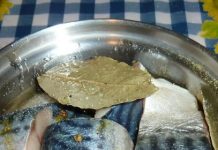Cottage cheese is made from cottage cheese much faster and easier than from milk. You can avoid the stages of fermentation and fermentation, using cottage cheese as a finished cheese grain. Long exposure under the press and many months of ripening are also not needed. A day after cooking, you can proceed to the most pleasant stage - tasting.
Material Content:
Classic recipe
For the preparation of homemade hard cheese, natural farm cottage cheese is used, in which there is no palm oil, chemical stabilizers, preservatives or other inappropriate ingredients.
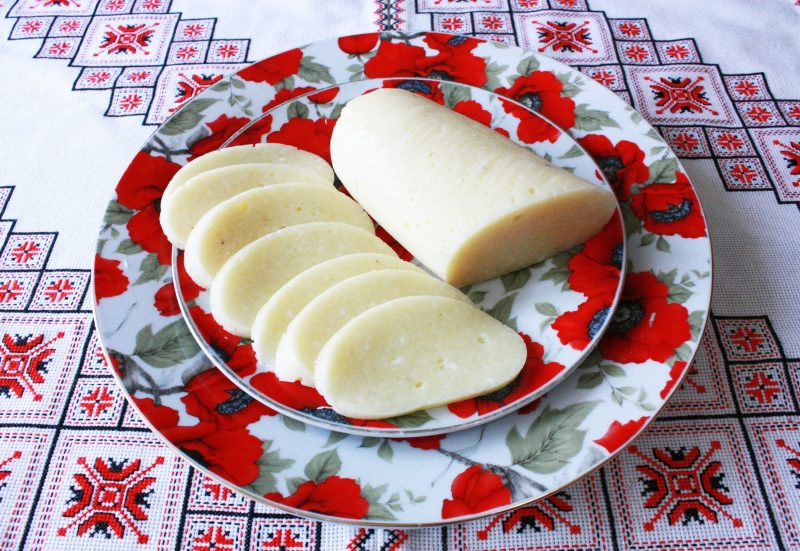
Per kilogram of cottage cheese:
- 100 g butter;
- one egg;
- 10 g of salt;
- 15 g of soda.
For work, you will need a 3-liter pan, a pan with a bowl for a water bath, a colander with a fine mesh and a container for collecting serum.
- Boil 2 liters of water in a deep saucepan.
- Rub the cottage cheese with your hands or a pusher to break all the large lumps.
- Put it in hot water and boil over low heat for 20 minutes, not allowing it to boil with a key. In the process of heat treatment, the cottage cheese will begin to melt and excess fat will come out of it. Water will turn into whey, which can be used for baking or okroshka.
- Put the cottage cheese in a colander, so that the liquid comes out of it. You can tamp it slightly. If the mesh is too large, several layers of gauze are placed on it. Through it, the mass is easy to squeeze. Get a fairly tight lump of sticky cottage cheese. Soak used dishes immediately, because dried cottage cheese is very difficult to wash.
- Melt the butter in a hot water bath.
- Put a lump of squeezed cottage cheese in a bowl with oil and rub it thoroughly again.
- Salt, add soda, so that the curd melts more easily, and a beaten egg so that the finished cheese can harden.When soda reacts with lactic acid, the curd mass noticeably increases in volume, becoming soft and lush. Egg yolk slightly stains it.
- For 5 to 7 minutes, the cheese mass must be continuously mixed so that it warms up and is heated from all sides evenly. It should turn out to be a completely homogeneous, viscous mass. It separates well from the walls and gathers in one lump. The longer the cheese is boiled, the harder it will be.
- Arrange the cheese mass in the molds carefully, without voids. Fill the container to the top so that no air remains under the sealed lid.
- Cool completely and keep cool for 5 to 10 hours so that the product hardens.
From one kilo of raw materials, 0.5 kg of the finished product is obtained. Home-made cheese from cottage cheese is stored for 10 days in the cold in an airtight container.
Recipe with the addition of milk
To enrich the taste of homemade cheese and emphasize its creamy aroma, cottage cheese is melted in milk.
Per kilogram of curd:
- 1 liter of milk;
- a pair of eggs;
- 100 g of oil;
- 10 g of salt;
- 15 g of soda.
Milk with a low fat content is quickly fractionated, so you can use regular (2.5%) from the store.
- Grind the cottage cheese, put in milk and warm, not allowing the contents of the pan to boil.
- After a few minutes, the milk will be divided into a transparent whey and curd flakes, a thick precipitate will become sticky and soft. It is important to closely monitor the process and remove the pan from the heat on time. Cheese made from milk and cottage cheese is very moody. It is too early to drain the whey, otherwise the cheese will not work. If the cottage cheese is digested, it will become elastic and tough, like rubber.
- Transfer the curd mass into a fine sieve and squeeze. For this it is convenient to use a slotted spoon with a long handle.
Then you can cook cheese in a water bath, as in the classic recipe, or you can simplify the process a little.
- In a saucepan where the cottage cheese was cooked, melt the butter.
- Put the squeezed cottage cheese in it and rub it thoroughly again.
- Boil the curd for several minutes, evaporating the excess liquid. Cottage cheese must be actively stirred so that the mass is evenly drowned.
- Beat eggs with salt and soda in a separate bowl. Combine them with cottage cheese, continuing to mix continuously.
- At first, abundant foam will rise, then it will settle, and the mass will noticeably change: it will become homogeneous and viscous. The quality of the future cheese depends on how much cheese mass is boiled.
- Transfer the hot molten cheese into molds, cool completely and only then seal tightly.
- Put in the refrigerator for a day or at least for the night.
Homemade Hard Curd Cheese
From the store fat-free cottage cheese, you can quickly prepare the basis for a variety of experiments with original flavors.
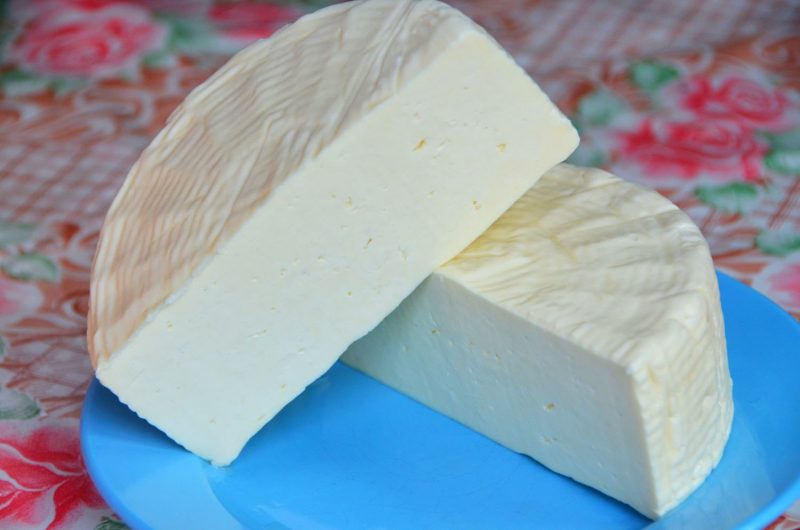
Products per 0.5 kg of cheese:
- 1 kg of cottage cheese;
- two eggs;
- 130 g butter;
- 10 g of salt;
- 15 to 20 g of soda.
Homemade hard cheese can be prepared with any toppings: mushrooms, seafood, smoked meats, hot peppers, herbs or spices. The possibilities for experiments are not limited, but do not forget that additives can affect the shelf life of cheese.
- Melt the butter in a deep pan. Put the cottage cheese and grind it.
- Beat eggs, salt and soda. Combine the ingredients.
- You can not boil cottage cheese, as there is no excess fat in it, but you will have to increase the melting time of the cheese mass. The liquid in the pan is also small, so you will have to mix the cottage cheese especially actively. The cheese mass will be heated for 10 minutes.
- At this time, all the fillers and seasonings are introduced into it.
- When the cheese in a pan starts to gather in a lump, you need to pack it in small containers of 250 ml. This way it is easier to avoid the formation of voids in which condensation can accumulate.
- It remains to cool the product and seal it tightly. Keep in the refrigerator for at least 12 hours.
Soft curd cheese
In quality, such cheese resembles cheese. It is wetter than hard cheese, and can even turn out to be a bit grainy.
- 0.5 l of milk;
- 0.5 kg of fat cottage cheese;
- 50 g butter;
- 5 g of salt.
The remaining fillers are chosen to taste: salted, smoked, spicy additives, fresh herbs, seasonings and spices. Soft cheese can even be made with sweet toppings, such as chocolate. But also in kind, it is very good.
- Cottage cheese is melted in milk until the whey is separated.
- The liquid is drained. The sediment is thrown into a colander.
- When most of the liquid drains, the curd is transferred to a bowl and mixed with the rest of the ingredients.
- Spread the mixture in gauze or a smoother cloth and squeeze.
- A bundle with cheese mass is tightly tied and suspended over a container for collecting whey for 4 - 5 hours. The convolution unit can be fixed on the long handle of the ladle located above the deep pan. Much faster whey squeezed out under the press. For 2 hours, a package with cheese mass is placed in a colander and covered with an inverted plate, on which a small load is placed. For example, a jar of water.
- Soft cheese is stored in airtight containers for no more than 5 - 7 days.
How to make Cream Cheese
Another version of soft cheese is creamy, a bit like processed cheese.
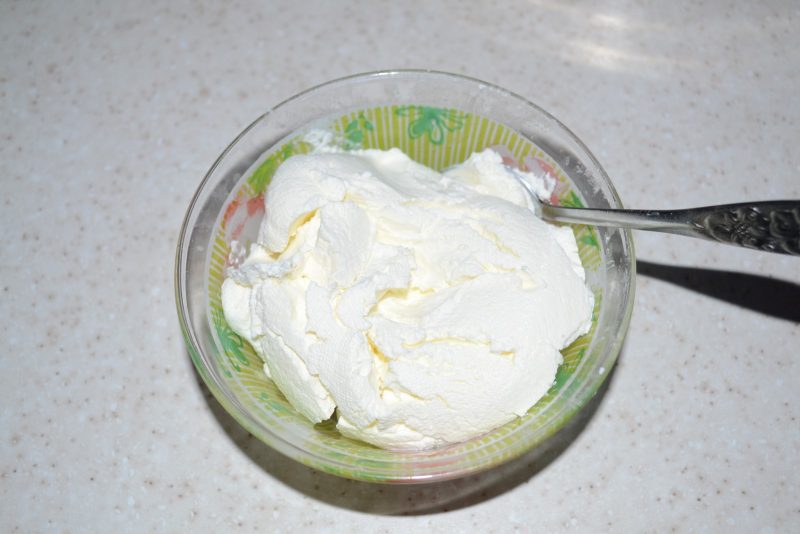
For 250 g of cheese:
- 0.5 kg of cottage cheese;
- two yolks;
- 50 g butter;
- 5 g of salt;
- 10 g of soda.
Preparing soft cheese in a steam bath:
- Cottage cheese, mashed with yolks, is laid out in the melted butter. Proteins will make the product solid, so the eggs must be separated very carefully.
- Add salt and soda.
- Melt the cottage cheese for about half an hour or a little less. The longer the cheese is cooked, the harder it will be. But there is no need to rush - there should not be curd grains left in it.
- The finished mass is poured into small forms, oiled, cooled to room temperature, covered with a lid or film and cleaned in the cold.
The shelf life of such a product is only 5 to 6 days.
Cooking Cream Cheese
In the process of preparing cream cheese, the mass almost does not lose liquid, so the cheese is obtained as much as cottage cheese was used.
For 500 g of cottage cheese:
- 100 g butter;
- 5 g of salt;
- 10 g of soda.
Oil can be replaced with sour cream. It will need half as much, and the cheese will turn out to be low-fat. To make the mass thicker faster, add one egg.
- All ingredients are thoroughly mixed with a hand blender.
- Heat the composition in a water bath until a uniform, thick sour cream. The cottage cheese should completely melt. This will take 10 to 15 minutes. All this time, the cheese mass is mixed so that it evenly warms up. This is convenient to do with a blender.
- Pour the finished cheese into greased tins. You can add to each different fillers, 10-20% by weight of cheese.
- Cool the product, mix the fat film formed on the surface and put in the refrigerator.
You can store natural processed cheese from cottage cheese for 5 days, and cheese with additives is half as much.
Step-by-step Mascarpone cooking
The famous cream cheese in Italy is made from buffalo milk. In our supermarkets, most often you can buy a product made from ordinary cow's milk, although such a substitute is quite expensive. You can easily cook it at home.

For greasy and soft homemade Mascarpone:
- 400 g of cottage cheese;
- 20 g butter;
- 200 ml of heavy cream.
The humidity and structure of different types of cottage cheese are different, so cream needs to be added a little. You may need a little more or less fluid.
- Cream is cooled to 4 - 5ºС.
- The cottage cheese and softened butter are whipped with a blender until a homogeneous dense mass and cool for 30 minutes.
- Again, quickly beat and pour a thin stream of cream, continuing to work as a blender. All the time you need to monitor the state of the cheese mass. It should become dense, but not thick, homogeneous and shiny, very similar to a cream.
You can store such a product for only 3 to 4 days.
From goat curd
Goat milk is richer in composition than cow's milk, more beneficial for the body and does not cause allergic reactions. But not everyone likes its specific smell and taste.It is especially difficult to include it in a child’s diet. Goat cheese does not have such a bright smell, while it retains all the beneficial properties of milk. Due to the optimal ratio of fats and proteins, goat cheese has a special delicate taste that will attract any gourmet and fussy. Making homemade cheese from goat cheese is as easy as making it from cow cheese.
From 1 kg of cottage cheese, 600 to 650 g of cheese is obtained:
- 1 kg of goat curd;
- 1 liter of goat hassle;
- 100 g of oil;
- 15 g of salt;
- 10 g of soda.
Cheese will be harder if you add one egg to it.
Most often, Provencal herbs are added to goat cheese. The rest of the fillers should be made with caution, given the original taste of cheese.
If you replace the milk with water, the specific smell of the finished product will be less noticeable.
- Cottage cheese is melted in milk until the whey is separated.
- All ingredients are heated in a water bath until smooth. This will take 10 to 20 minutes.
- The composition is poured into molds and cooled.
If you use twice as much milk as cottage cheese, small holes form in the cheese and its texture becomes more tender.
The melted cheese mass will turn out to be watery, it must be kept in a colander under a press for 4 - 5 hours. At this time, the structure with the load is best placed in the refrigerator.
Cheese, cooked at home, in no way loses to the store. And even if the cottage cheese was prepared independently from good rural milk, then such a product is also much more useful than the purchased one.


